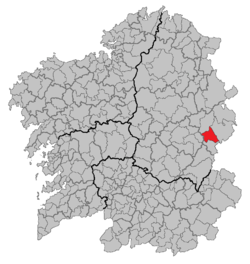Geography
The town stretches along the southern foothills of the Sierra de los Ancares and the valley formed by the upper reaches of the river Navía. It is a vast territory at 112.4 km2. As Nogais has a very low population density with less than 15 inhabitants per square kilometer. The maximum height is in the Sierra de los Ancares in small hills like Travesa, Chan Pintinidoira and Pereira (between 1,000 and 2,000 m) and in the foothills of the Serras del Piornal and Rañadoiro. To the south and southwest the municipality exceeds 1,300 meters, reaching 1,387 meters at Pico do Corvo.
The Navia river, which begins in the Piedrafita del Cebrero, crosses As Nogais from southwest to northwest and collects water from, among others, the Valdeparada river and the stream of Boullón.
Winters are cold and summers are cool, with an average temperature of 9 °C and a temperature variation of 13 °C.
History
There were settlements of Castro culture, such as the fort of Vilabol, Vilaesteva and Quintá. Located here is the Roman bridge of Ponte Naviae along the road from Braga to Astorga. On the road leading to Castile, the hardest part of the climb to Piedrafita began here. This entry to Galicia was defended by the Doncos tower and castles of Doiras and Valcarce. In the fourteenth century, Doncos was property of higher elder in Galicia named Garcia Rodríguez de Valcarce. In the fifteenth century Doncos belonged to the Earl of Ayala and Countess of Monterrey. But in 1603, when it was owned by Fernando de Toledo, it was already an abandoned tower.
The ecclesiastical advantage belonged to the house and lordship of Tores, possession of the Marquis of Camarasa. It seems that in the place of Santo André was a hermitage, converted to a monastery and quickly disappeared.
During the War of Independence of Spain, French troops burned Doncos and other sites as well. In 1835, neighbors formed a party of volunteers that prosecuted the Carlists.

In Spain, a comarca is either a traditional territorial division without any formal basis, or a group of municipalities, legally defined by an autonomous community for the purpose of providing common local government services. In English, a comarca is equivalent to a district, county, area or zone.

Lugo is a city in northwestern Spain in the autonomous community of Galicia. It is the capital of the province of Lugo. The municipality had a population of 98,025 in 2018, making it the fourth most populous city in Galicia.

Boal is a municipality, a civil parish and a town in the Autonomous Community of the Principality of Asturias (Spain). It borders north with El Franco and Coaña, south with Illano, west with Castropol and east with Villayón.

Abadín is a municipality in the province of Lugo, Galicia, Spain. It covers 196.1 km² and has a population of 3,250 for a population density of 16.57/km². It resides in the region of Terra Cha.

Castroverde is a municipality in the province of Lugo, in the autonomous community of Galicia, Spain. It belongs to the comarca of Lugo.
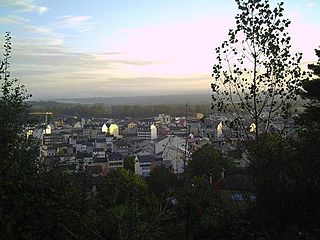
Sarria is a municipality in the province of Lugo, northwestern Spain, in the autonomous community of Galicia. Sarria is the most populous town on the French Way in Galicia, with 13,700 inhabitants and the major is Carmen José Lòpez. It is head of the region and the most popular starting point for the Camino de Santiago; many pilgrims choose Sarria because the distance from this point to Santiago allows them to cover the necessary kilometers to reach the Compostela. King Alfonso IX of León died in Sarria in 1230 while making a pilgrimage to Santiago de Compostela.
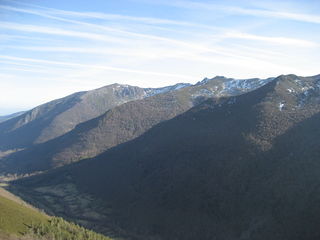
The Serra dos Ancares is a mountain range of the Galician Massif in north-west Spain, extending in a south-westerly direction from the western end of the Cantabrian Mountains in Asturias.

Cervantes is a municipality in the comarca of Os Ancares, in the province of Lugo, Galicia, Spain.
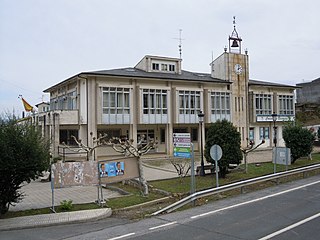
Becerreá is a municipality in the province of Lugo, in the autonomous community of Galicia, Spain. It belongs to the comarca of Os Ancares.
Samos is a municipality in the province of Lugo in Galicia, Spain. It contains the village of Samos.
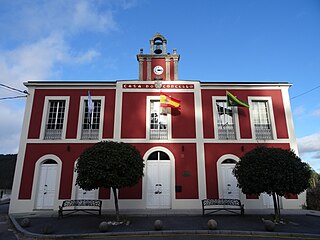
Ourol is a municipality in the Spanish province of Lugo. It belongs to the comarca of A Mariña Occidental.

Os Ancares is a comarca in the Galician Province of Lugo. The overall population of this local region is 13,888 (2005). It is formed by the municipality of Candín with two slopes, Sil and Navia, and separated by the Ancares pass.

Pedrafita do Cebreiro is a municipality in the province of Lugo in Galicia, Spain. It borders the Lugo municipalities of As Nogais, Cervantes, Folgoso do Courel, Samos and Triacastela. Its eastern boundary borders the province of León. It belongs to the comarca of Os Ancares.

A Pontenova is a municipality in the Spanish province of Lugo. It has a population of 3199 and an area of 136 km².

A Pobra do Brollón is a municipality in the Spanish province of Lugo in Galicia. It belongs to the comarca named Terra de Lemos. It has a population of 2,066 and an area of 175 km2.

Taramundi is a municipality in the Principality of Asturias, Spain. It neighbors on the north side with San Tirso de Abres and Vegadeo, on the east side with Villanueva de Oscos and Vegadeo, on the south side with Santa Eulalia de Oscos and A Pontenova (Lugo), and on the west side with Lugo.

The municipality of Colotlán is in the northern extremity of the Mexican state of Jalisco. The municipality covers an area of approximately 648 square kilometers. Colotlán is located at 22°12′N103°18′W. It stands at 1,550 metres (5,090 ft) above sea level.
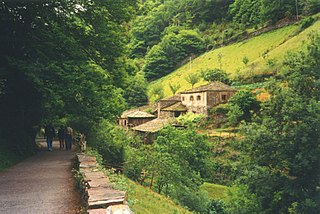
The Turia Valley is a small valley on the western border of the Cantabrian Mountains in the northwest of Spain which is close to beaches and is divided by two autonomous communities: Asturias and Galicia. It consists of an area of 90 km2, 3,910 inhabitants and is 200 m above sea level. The two main towns are A Pontenova (Galicia) and Taramundi (Asturias).
Suarbol is a village belonging to the shire of Los Ancares situated in the region of El Bierzo within the province of León. Both Suarbol and its neighbouring town Balouta are the last villages of the province of León before crossing towards the province of Lugo

The Galician National-Popular Bloc was a Galician electoral candidacy. It had as the national sovereignty for Galiza as its main objective and as an alternative to autonomism. It was formed by the Galician People's Union (UPG) and Galician National-Popular Assembly (ANPG).

